One of the most satisfying experiences I have when I’m marbling is hanging a finished sheet and realizing it is perfect. It doesn’t happen as frequently as I’d like, but it does happen. There are so many things that can go wrong and so many variants that sometimes it’s hard to figure out where the problem occurred. After all the papers are dry at the end of a marbling session, the first thing I do is to sort my papers into piles – saleable, usable, disaster and that rarity, perfect.
For my own clarification and maybe to help new marblers, I am going to try to look at the places where marbling can go wrong and maybe how to fix it. This will probably take several blogs and may be interspersed with other commentary.
PAPER
First comes the paper. You can marble almost any kind of paper, but the results will vary. I’ve only had two total disasters. The first was a very slick brochure, both the alum and paint tended to slide off . Some color did stick, but it was very messy. Slick magazine pages are very iffy, they might work, but they might not. The second wipeout was a heavy “cloth-like” paper napkin. It lay down on the tray well, but just wasn’t strong enough to hold the paint. When I lifted it from the marbling tray, it shredded.
Different weight papers may require slightly different techniques. I tend to catch bubbles on heavier papers because they don’t roll down as smoothly. If I switch paper weights, I find I have problems with the first ones until I get into the right rhythm. With anything that doesn’t bend, like mat board, I dunk the starting corner to keep the rest going smoothly. Antique paper, like pages from 19th century books, can be marbled if you handle it gently. It may need to be laid flat on a towel to dry, rather than being hung. Hanging weak paper, of any age, may tear the corners. Although I always rinse my marbling before hanging, I’ve found that a residue of carrageenan remains on the paper which seems to strengthen old paper. Another quirk I’ve noticed is that slightly acidic paper seems to produce brighter and crisper marbling. Almost all the the new paper I buy is acid-free, but I have stashes of print and watercolor paper that belonged to my Mother and they all have some acid content, as do the maps and book pages I use.
For my standard marbling, I use Strathmore or Canson drawing paper. For use in my books, I try to stay within the 90gsm to 120gsm range. For cards, I use standard card stock. I have some lovely pieces on very heavy weight paper, but haven’t figured out a use for them yet, other than framing! When I need a large colored paper, I use Pastel paper, either Strathmore or Canson Mi-Teintes.
ALUM
I’ve read many times that you should not use grocery store alum for marbling, but only buy that expressly labeled for marbling. Guess what? They are right. I had to try some from a bulk food store that was just labeled “alum”, not “pickling alum”. It did work, but I had a lot more papers that had alum streaks than usual.
Problems with alum are pretty easy to spot. If there are grainy, greyish spots or spots where there is washed out color, it’s probably due to an incomplete application of alum. The predominate problem I’ve had with alum, however, is user generated. I use the non-alumed side by mistake.
- Torn corner from weak paper
- No alum, probably wrong side
- Paint washing off due to lack of alum
- Alum spotting
CARRAGEENAN
I’ve had few problems related to the carrageenan overall. The proportions are important as is the blending time. I use 2.5 Tbs. per gallon of water and blend for at least one minute. (I have very hard well water so I use bottled distilled water. Most people can use tap water.) It can last for up to a week, but I did have one batch that started breaking down after two days. Sometimes it is hard to distinguish between a paint problem, a carrageenan problem and general contamination. In one particular case, I’m pretty sure it was just the carrageenan, because I mixed a new batch and the next day the same paint was fine. Contamination in the tray can usually be solved by a good skimming. Just be careful to skim only on the top. If you dip too far into the carrageenan, you risk recirculating all sorts of bad stuff that has sunk to the bottom of the tray. Since all marbling takes place only on the top surface, what’s underneath can’t hurt, usually. You can tell that the carrageenan is “worn out” if the problems affect all the colors. It also seems to manifest with globs with squarish sides rather than the rounder dots from paint problems. The only solution for over-used carrageenan is to toss it and start again.
By the way, dirty carrageenan is Okay. In fact, it seems to work better after having a bit of paint in it.
- Probably carrageenan breakup or severe contamination
- Problems with carrageenan or paint?
UPDATE: See my blog on “An Interesting Carrageenan Disaster” for a real problem I encountered. In hindsight, I think I must have mismeasured the carrageenan and added an extra tablespoon.
PAINT
If you are planning to do a lot of marbling or marbling something special, it pays to start with quality paint. I use Golden Fluid Acrylics because of their high pigment to carrier ratio. That means more intense colors even when the paint is thinned. They come in a wide range of colors and in several size bottles. Start with the 1 oz. size. When you are using paint one drop at a time, you can do a lot of papers with 1 oz. Since you want the paint to float easily, avoid any “heavy body” paints. You should also avoid any paints meant for children. The cheaper paints have less pigment and can be unevenly blended causing problems for marblers.
Getting the paints balanced perfectly with your size can be very tricky. One of the most obvious problems is having the paint contract into a tiny ball and drop to the bottom of your tray. This happens when the paint is too thick or heavy in relation to the size. The solution is usually to add more water to the paint, a few drops at a time. Alternatively, a surfactant can be added to the paint. I use Golden’s Acrylic Flow Release. Photo-Flo from Kodak can be used and marbling gall is used with watercolors. Getting colors to spread instead of drop is usually just a matter of patience and trial and error. I haven’t found a solution to the opposite problem, when a single drop of paint fills the entire tray! Reds and yellows are especially prone to spreading. To reduce the spread, you can try to add more paint, but I’ve found it’s easier just to start over with fresh paint and add water just a drop at a time until you have the right consistency. I always mix very small amounts of paint to start so I don’t feel badly if I have to throw some out. Unlike painting, marbling is a matter of drops, not huge amounts.
Some paint will always drop out, at least it always does for me, but at the end of a session, the bottom of your tray should not be coated with a build-up of paint. Some scattered drops are normal.
A common problem I have is the paint granulating or stretching apart into tiny particles. This is especially noticeable when using metallics, but it happens with other colors. I haven’t found a real cure yet, but repeated stirring seems to help keep the pigments in suspension. Just don’t stir so vigorously that you make bubbles. They are a real pain to eliminate.
- Some granulation of the copper
- Silver granulation
- Granulation
- More breaking apart
If you click on the photos and examine the larger size, you can see where the paint has begun to break down. The finer I make the lines in the pattern, the more break down occurs. In some instances, like the silver and blue, the effect is gossamer, sparkly strands; in others, it is just a mess! The less you manipulate the colors, the less break down.
USER ERROR
Of course the most frequent source of problems is just me, especially in laying down the paper. All sorts of messes can occur, but air bubbles caught between the paper and the size are my most frustrating problem. I have a gorgeous pattern in the tray and then a big bubble ruins it.
- Huge air bubble on black paper
- Large bubble plus weird brown paint
- Smaller bubble
- Small bubble creating drag lines
Hesitation lines are another problem I have on a regular basis. The lines occur when your paper isn’t placed on the paint in a smooth motion. Where you hesitate or jerk your hands, a line of paint forms. This can be a desired result when you are making a ripple or moire pattern. I frequently have problems with the last corner and there’s a little line right there. Hesitation lines are one of the reasons I don’t usually work with paper larger than 14″ x 17″. I’m short, my arms are short and stretching over a larger tray with longer paper results in lots of dips and lines.
- Ripples on purpose
- “Worm” at top, hesitation line in bottom corner
More examples to come.
To be continued …

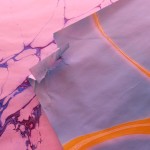
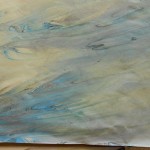
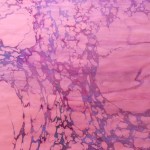
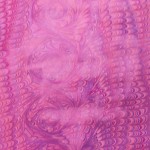
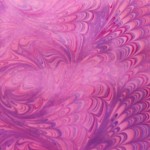
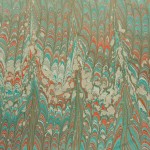
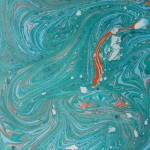
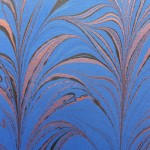
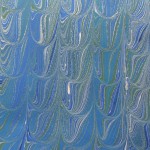
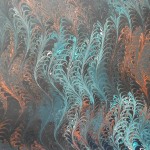
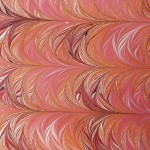
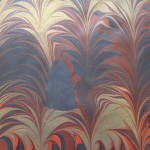
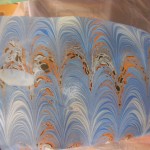
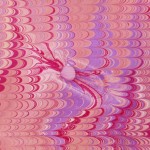
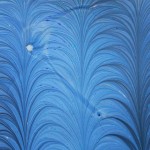
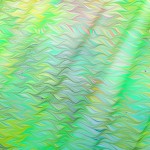
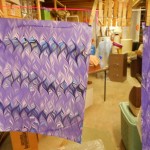
Hi Nancy,
I have been experimenting with marbling and have encountered a problem of which I can’t isolate the cause. I mix my carrageen following instructions (1 tbsp/quart), treat my paper (Canson watercolor paper) with alum (1 tbsp/cup), and start creating patterns with my watered down acrylics (50/50 water to paint). The paint floats perfectly and my designs are coming out beautifully…on the size. However, i print it and so much of the size remains on the paper but I can’t rinse it without everything coming off with the size…What am I doing wrong? I have tried letting the alum dry completely, keeping it somewhat damp, thinning the size.
Any tips are appreciated.
Thanks!
Lizzie
Lizzie,
I think your measurements are off. I use 2.5 Tbsp. of carrageenan to a gallon of water. One Tbsp. per quart would be four Tbsp. per gallon. What happened to you is similar to what happened to me in this blog. I don’t know why, but there seems to be some differences in sources. Also with the alum, it’s one teaspoon per cup – although I tend to use a bit more. The measurement of alum isn’t as important as the carrageenan. Try making in much thinner.
Dry vs. damp paper still hard for me to get it just right. What I find more important is that the paper isn’t wrinkled. Immediately after aluming the paper, I place it under a flat board with a brick on top. I leave it there while I’m getting everything else ready.
How do you wash the paper? Under running water or in a tray? I find using a tray is much “gentler” and you lose much less of the paint/design that way.
Good luck with your marbling. I think if you change the carrageenan to 2.5 per gallon, you’ll be fine. If it doesn’t work, let me know and I’ll try to figure it out.
Enjoy,
Nancy
Hi there:)
im hope u can help me
my size keeps breaking after one day, im using good water etc and the work seems fine. however on the second day when i drop paint in a area which has been still it breaks the surface and then drops?
does that make sense?
cheers
sarmarie
Sarmarie,
What are you using for size? Carrageenan or Methyl cellulose? Do you cover your size overnight? Covering it will help reduce contamination from dust. Do you cover your paints? If you leave your paints open, they may be evaporating just enough to thicken.
Usually when the paint just drops, it is a problem with the paint being too thick or heavy. What brand of paint are you using? The first solution to try is just to add a drop or two of water to the paint. If that doesn’t help, try Golden’s Acrylic Flow Release – again just a drop.
Try that with several different colors. If all the colors continue to drop out, that will show that the problem is probably with the size.
Make sure your proportions of size to water are correct – 2.5 Tablespoons size to 1 gallon (US) water.
Mix in blender. Don’t try to stir it by hand or use a food processor, it doesn’t blend as well. If you don’t have a blender, your local thrift shop is a great source for one. I bought mine for $3.
I’m sorry you are having these frustrating problems. Let me know if anything works.
Nancy
Nancy
I am using carrageenan size and Golden paint. I added oxgall but am having a problem with the paint first creating a circle, but then contracting and having jagged edges. I didn’t add any water to the paint at first, but the same thing happened when I did,the colors were just lighter. I did try adding water to the size, but that didn’t help.
Also, I am trying this in a small pan until I get the hang of it, would that maybe cause a problem?
Thanks
Wendy
Wendy,
Thanks for reading my blog. The jagged edges are probably caused by contamination on the size. It could be dust, a bit of old paint, alum residue, most anything. You have to skim the size carefully after each sheet. I use strips of newspaper about 2″ wide. Hold them by the ends and let the long edge just touch the size, start at one end, pull the paper toward you and any paint or dust will be caught. Do this 3 or 4 times or until you can’t see any color on the newspaper. Don’t dip the paper into the size more than an 1/8th inch, because that will stir up the paint that has settled out. Some people prefer to take a piece of newspaper the size of your tray and lay it down as if you were marbling. That will also remove most of the paint, but you may have to skim the edges separately.
If the paint is dropping to the bottom and leaving a blob after it contracts, it’s too thick – add water** first (about half and half) and if it still does it, add surfactant. I don’t use oxgall as a surfactant. I much prefer Golden’s Acrylic Flow Release. Not as smelly and easier to control. When I first started using it, I added a drop to every color, but I’ve found that not all colors react the same, so now I wait until I’ve worked with the paint for a sheet or two and add the Flow Release only as needed. Reds & yellows almost never need it Ultramarine colors always do! I assume you are using Golden’s Fluid Acrylics. I found the High Flow Acrylics to be too thin and spread too much. The regular “artist” acrylics are too thick to be used easily.
How small is your pan? What is it made of? I don’t use metal pans at all as I don’t trust them not to react chemically with the size. My classes use an 11″x14″ frame (as shown in the photo above). They come in all sizes and are inexpensive.
In short, skim well, try the paint first with just water added, try just a drop of surfactant and keep playing until it works!
Good luck and I hope this is helpful and you enjoy marbling!
Nancy
PS If your print is too light, just keep adding more color to the tray rather than messing with the colors. Every time you add a new color, the old colors compress and get darker. Drop the darkest color first – I frequently use black or white – and it becomes the strongest color.
** You might want to try a test with bottled distilled water for both carrageenan and paint to see if there is something in your water that is causing problems. I have to since I am on well water with a conditioner – all sorts of minerals and stuff in my water.
Nancy,
I am brand new to marbling. I ordered a kit from Dharma. My size seems to be fine, but when I drop my paint straight from the bottle it spreads to the point you can’t tell I dropped anything. It is Jaquard paint. Have you seen this happen before? I called Dharma they said to put paint in frig but that didn’t help either.
I have never used Jaquard paint. I stick strictly to Golden’s Fluid Acrylics and I love them. Are you dropping your paint with whisks or droppers? I recommend using droppers to start as they let you easily see what is happening with your paint. Any paint will be very faint on the first drop, but as you continue with the second and third rounds of drops in the same place, the colors will darken and show more definition as each successive drop “pushes” against the previous paint. If you study the photos on “Marbling, Step by Step” you can see each ring develop. Notice that when I dropped the yellow it pushed the rings farther than the previous colors. This is because the yellow was “stronger” than the other colors.
You can test this out by using just a bit of carregeenan in a bowl and try dropping paint on it to see how much paint has to be dropped before you can see the paint clearly. This way you aren’t wasting time, effort and materials for a full tray.
The other thing you want to check is the bottom of the paint bottle to make sure that some of the pigment hasn’t settled out. Certain colors, like the ultramarines, are prone to settling and need to be stirred or shaken frequently.
Good luck and keep trying and testing. It’s well worth it when you get the balances just right and can start having fun.
Nancy
Hi there, Nancy,
I am having some troubles and I am hoping you can offer some advice. I bought some paper (talas) that was recommended for marbling. I treated it with an alum mixture that another forum told to do with 1 tsp alum to one cup water. My carrageen mixture is 1 tbsp plus 1 tsp to a gallon of water.
Sometimes I have issues with paints, but not as bad as my issues with paper/mixtures. When I rinse my paper, the Cathleen completely stays on and sometimes crystizes when dried. If I try to get it off, it takes my paint with it.
Do you have suggestions for the mixtures, paints or papers??
Thanks!
Lizzie
I think it is hilarious that I didn’t search the comments to see you had already helped me before!
I am on my phone and your blog looks different so I never even noticed I had already found you.
Thank you for the advice. I will try a thicker carrageen and a tray to clean!
Thanks
Lizzie
No problem! At least I know people can find me on their phones! I read your original post again and saw you are using watercolor paper. What weight is it? I find that anything over about 200lb. needs to be handled a bit differently than lighter papers. I use drawing weight ( 80 to 120 lb.) primarily as it is a better weight for bookbinding. Heavy paper, especially absorbent paper, needs to rest a bit longer after being alumed. You also need to make sure the back is wet when rinsing. If the back is dry and the front wet, it will tend to curl and can dry unevenly causing the paint to crack or shift. I also leave it on the tray just a bit longer, but I don’t know it that makes any difference or is just habit. Watercolor paper is much more porous than drawing paper and I like to give it a few seconds more to absorb the paint, but I admit that that may be just my idea.
Good luck,
Nancy
Hi Nancy,
Your blog has been a great source of help and insight through my marbling journey!
I’m having one frustrating problem though. My Liquitex Ultramarine consistently sinks to the bottom of the size. I have produced great looking prints with no problems with all other colours, (greens, yellows browns and reds) but the blue keeps sinking. I have tried increasing water proportion in the paint, or adding more ox gall than I do in the other colours. But nothing works! I’m at my wits end and would love it if you could help me out!
Thanks for the nice comments. I’m planning to overhaul my whole “How to Marble” blog, because of all the questions I’ve had. Just haven’t had the time.
I started marbling with Liquitex and then switched to Golden Fluid acrylics. I found a huge difference in the way they worked. I assumed I’d use both for a while, but once I changed, I was hooked and finally gave all my Liquitex away! I have almost no problems with Golden, they mix quickly and last a long time.
The Ultramarines (both blue and purples) are difficult colors. There’s something in their chemical/physical make-up that doesn’t like marbling. I’m not sure exactly why, but I find that even in the Golden those pigments tend to drop out of suspension and I’m constatly have to stir them before dropping on the size. The only suggestion I have is to try some Golden Acrylic Flow Release instead of the ox gall. It is a wonderful surfactant and adding only one drop to your paint usually makes it spread beautifully. Of course, the other solution is to give in and use Cyan or Thalo Blue, or one of the many others. Here’s a link to the Wiki article on Ultramarine Interesting, but not much help.
Keep playing with adding water, ox gall or Flow Release and you should find a magic solution at some point. If not, just try other blues. I remember when I was using Liquitex there was a black (forgotten if it was Carbon or Mars) that I never could balance properly, so sometimes it is just the paint and not you.
Good luck!
Nancy
hi there nancy 🙂
thank you for your blog, so helpfull reading other peoples comments :). im new to marbling only started 5wks ago and im marbling almost everyday. iv been using methyl as my size but thought id try carrageenan yesterday. im finding my paints especially black just takes off and takes over the whole tray very quickly, also when i draw my designs free hand its just so thin it moves and the pattern all muddles together so im finding it hard to draw my designs. with the methyl it was quite thick and would hold the paint still, but i had a cple problems with that too, the stones came out jaggered etc…carrageenan just makes the stones so crisp and clear so id really like to keep using it. can you give me any advice? thanks keelyn
Keelyn,
I’ve never marbled with methyl cellulose, so I can’t really help with that. The ratio I use with carrageenan is 2.5 Tablespoons to one gallon of water. That’s the first thing to check. When I was starting to marble, I found the hardest thing was to balance all the colors so that they spread at approximately the same rate. Certain colors – reds, yellows, white – seem to always spread farther than others -blues, greens). The trick is to adjust the amount of water and surfactant (ox gall or Acrylic Flow Release or PhotoFlo) for each color. Your first couple of trays every session should be just testing the colors. It’s much, much easier to get a paint to spread faster, than it is to “thicken” it, so I always start with my paints on the thick side and gradually, just a few drops at a time, balance it.
I find using eggs or circles, rather than throwing stones, makes balancing easier because you can really see how each color reacts. With stones, sometimes it’s hard to tell which is dropping out and which is overwhelming the others. With carrageenan, the first color dropped will spread quickly, but if you drop your second color inside the first, it should spread also. If you study the photos on my “How to Marble” blog, you’ll see what I mean. BTW, those photos were taken before I started using Golden Fluid Acrylics, so the colors are more opaque.
On the second point about drawing on size, marbling is not like other forms of printing or drawing. You are using a fluid medium and it will flow and move. That’s what makes it special. There are ways of doing it, but it requires special techniques. You can see wonderful examples of Turkish Ebru marbling on YouTube which show it in detail. I would suggest that before going in that direction, you spend a week doing basic patterns just to learn the feel of the medium. Producing a perfect get-gel or nonpareil or feather pattern will give you a sound foundation to go off into your own designs.
Happy marbling!
Nancy
PS Jagged stones usually means the size is contaminated and needs a more complete skimming. You should skim after every paper, even though it seems to waste paint.
Thank you for replying so quickly, you’re amazing!! I feel calmer knowing now I haven’t been causing the problem and that there are potential solutions that could work. I’m definitely going to give the flow release and the golden fluid acrylics a go, and in a worst case situation, succumb to thalo blue .
Thank you again, you’ve been so helpful. I’m looking forward to seeing the overhaul of the blog you have planned.
Hope you can help, one paper comes out great, then the next the paint kinda smears on the page, sometimes I can fix it when i rinse the paper, sometimes it doesnt help. What am i doing wrong that causes the smearing of colors ?
thank you
Hi Mike,
Thanks for reading my blog. Hope I can help.
Usually, the paints smear when there’s too much paint on the size. If you are also having problems with the colors dropping out to the bottom of the tray, then that’s definitely the cause. When you lay the paper down, it can only absorb so much paint and any extra paint on the paper will run or smear. Since you also mention that it comes off in the rinse, I suspect that’s the problem. Try dropping half as much paint, see how that works. If the colors are too pale, gradually increase until you have the perfect balance between intensity and smearing. You will probably find that not all the colors smear. I occasionally have smearing problems with black.
Other factors to check – Is the paint too thick? Add water a few drops at a time or a surfactant.
Is the paper too slick? Some glossy papers just won’t marble easily.
Is the carrageenan too thick so the paint doesn’t spread? Two & a half Tablespoons to a gallon of water should be ideal.
Let me know if this helps or if you have further questions. Marbling is a constant act of balancing, testing and adjusting.
Best of luck,
Nancy
Thank you so much, very kind of you to answer so quickly. Oh you said 2 and half tablespoons full to a quart ? or did you mean gallon?
thank you again
You are absolutely right! I should have said gallon. I’ve edited it in my reply.
Thanks for catching that!
N.
Thank you so much for this wonderful information.
I just started marbling a couple of days ago and absolutely love it. As an artist I tend to he super critical and this medium which requires acting quickly but surely is nice.
The marbling I’m focused on now is framed beauty pieces, what paper would you suggest is best for that?
I’m using a general multipurpose copy pay for practice, but want something more professional than thus flimsy crumpling paper.
Thank you so much, I love your blog!
Thanks for the compliments!
Because I use my paper in bookbinding, I usually use drawing paper, either Strathmore or Canson (70 or 80 lbs/ 114-130gsm.) However, I have tried everything from tissue paper (didn’t work very well) to heavy 400 lb. watercolor paper to mat board. I also regularly use card stock (65 lbs. /176 gsm) if I’m planning to make cards, folded boxes or anything that needs a bit more stiffness. My only advice is to try everything and do a lot of experimenting. Very light weights, including regular copy paper, are more difficult to handle and very heavy weights that don’t bend are hard to lay down smoothly. When you are first learning, it’s a good idea to stay away from glossy papers as some paints don’t adhere well and it can take some juggling to get a good result.
Keep playing and keep experimenting. Eventually you will find the paper that feels just right for you.
Good luck & have fun. If you run into any other problems, just ask and I’ll try to answer.
Nancy
This blog is a great find for me! I’m printing out all the helpful comments!
Nancy, do you ever teach classes? If so, where?
Susan,
Thanks for the compliments. I do occasionally teach marbling classes at the Arts Center of Yates County in Penn Yan, NY and I have “open studio” sessions where one or two people can come and marble along with me. I provide all the materials, but no formal instruction. The open studios are very informal and set up when it’s convenient.
Nancy
May be something fun- its about 5 1/2 hours north to where you are, but I may try for a spring or summer arrangement. THanks!
Please forgive me if my questions are repeats of others….I am new to this blog!
I am finding lots of references to using Windsor & Newton Galleria paints, and just bought a few colors to play with. I’ve added 2 tablspoons paint to 1 tablespoon distilled water for a start. No photo-flo (yet). I call this my “virgin” paint source.
Will be marbling next week, so will be adjusting the paints then. They all seem a bit thick to me….have you ever used the Windsor & Newton? SHould I keep the initial “virgin” mix thick, or go ahead and put a bit more water?
Susan,
Sorry for the delay in replying. I was on vacation with minimal WiFi access. (Yes, it is great to be unplugged for a while.)
I’ve never used Windsor & Newton for marbling, but just from looking at their web site, they may be on the heavy side for marbling and need more added water. That said, yes, I think starting with thick paint is a good idea. It is very easy to thin, but hard to thicken. You are much more methodical than I am! I just add a bit of water to a blob of paint, not very exact measurements.
Let me know how it goes. Good luck!
Nancy
Thanks, Nancy. I am VERY interested in taking a class with you. Please let me know when/where you might be doing something!
Susan
Susan,
I will let you know when I’m having a class again. Definitely won’t be until April or May since I don’t subject anyone else to my basement studio during the winter months. It’s a bit chilly down there!
Nancy
Dear Nancy,
It’s a pleasure reading your blog. I’m new to marbling and having a – probably -common issue. I’m in LA, so I used bottled water to make my size with carrageenan, 1tbsp +1tsp per gallon. I used a food processor since I don’t have a blender, and based on my research, wasn’t not sure whether that would fail completely, but the size seemed to gel fine, so I let it warm to room temp and tested it. I’m printing on leather, so I’ve been using acrylic leather paints, airbrush paints, and regular acrylic paints to test. So far, none of them work. They float fine, but once they hit the size, they fuzz out completely (either bleeding edges, crystallized edges, or just really fuzzy edges), bleed into each other, don’t mix, and then run all over the place when I print on alum-ed leather. This happens whether I dilute the paint or not. It’s a giant mess, and super frustrating. Clearly I am NOT doing something right, and I doubt it’s about the paint itself.
(I also have a major issue where I get air bubbles in each and every eye dropper I use, no matter how I do it! What is wrong with me?)
Any insight would be much appreciated. It seems ridiculous that it’s this dysfunctional!
Best,
Abby
Abby,
Thanks so much for reading my blog. I hope I can help, but it’s really hard some times to figure out what’s wrong without seeing it. First, a disclaimer – I’ve never tried to marble leather, so there may be something I don’t know that is causing the fail.
Your carrageenan proportions are off. It should be 2.5 Tbsp per gallon. That will thicken the size, but it won’t help with the bleeding. Size needs to stand at least 6 hours before you use it. I usually make mine the night before. You can leave it in your tray as long as you cover it or you can put it into another sealed container. A blender really is better than a food processor because of the higher speed. I picked up one at my local thrift shop for $3.
They float fine, but once they hit the size, they fuzz out completely This has me a bit confused, I assume the paint is floating on the size and within a few minutes become jagged. If that’s not what you meant, let me know. Jagged edges are usually caused by contamination. Are you skimming the size before dropping the paint? Skimming is very important and needs to be done before any paint is dropped and after every “print”. A clean surface on the size is a must. The contamination may also be in the paint itself and that’s very difficult to change, for example if somehow soap residue got into the paint, it would have to be tossed.
The bubbles in the eyedropper can have two causes. Obviously, if there are bubbles in the paint, they’ll get into the dropper, but they are probably created by releasing the bulb between drops, allowing air to get into the dropper. You need to maintain a steady pressure on the bulb, just enough for one drop at a time, not a squirt. Don’t squeeze and release, just squeeze and hold, squeeze and hold. It takes a bit of practice, but you’ll know when you get it just right.
Marbling is a marriage of many components and any one of them can throw everything off. I’d suggest fixing one at a time. First work on the size, make it 2.5 tbsp to a gallon and let it sit overnight. Skim it carefully. Next, work with the paint. Start with just one or two colors and start full strength. Then add a few drops of water to the paint, put a drop on the size and see what happens. Add a few drops of water at a time to the paint and keep testing until the paint forms a smooth circle about 6″-8″ in diameter with no dropout. Different colors will need different amounts of water. Reds & yellows spread farther than blues and greens. If the paint doesn’t spread after getting to a mixture of half water/half paint, add one drop of surfactant (I use Golden’s Acrylic Flow Release.) Once you have good circles, try a basic get-gel pattern. I highly recommend Golden’s Fluid Acrylics. They are more expensive, but are the best I’ve worked with. The 1 oz. bottles last a long time. I order mine online from Dick Blick, but you can get them lots of places.
If your pattern is stable, print it. Try printing on alummed paper rather than the leather at first. If it works, skim, drop new paint and try the leather. If it works on the paper but not the leather, then you have identified the problem, but I can’t help you. I’m not at all familiar with the chemical properties of leather and I imagine it would depend a lot on how the leather was tanned.
You didn’t mention your alum proportions, but if the colors are sliding off the paper or leather it is usually an alum problem. For paper use 1-2 tsp.+ per cup of water and leave the paper under light pressure for at least 15 min. before printing. It may take longer for the leather to absorb the water or the leather may be coated with something to make it water-repellent and won’t take the alum. I really don’t know about that.
Good luck with it all and just keep trying, step by step.
Please let me know how it goes and if you have other questions, ask.
Nancy
Nancy –
I just want to tell you how touched and inspired I was by your generous, detailed reply! I went right out, picked up a blender, and started over, following your suggestions, and everything changed! The size was completely different, and works properly now – because I’m using leather paints, I thickened your recipe a little – and now I’m on to working with the paints, which appear to be behaving for the most part. Funny how certain a greys spread (or don’t) so differently from black, etc. When I have concrete results to share, I’ll update you. I just had to thank you for setting me right. I’ve told my friends about your support and everyone is stoked I found an artist happy to help me! Thanks again, and more later.
Best,
Abby
So glad the information was useful!
Happy marbling!
To anyone reading this post- just spent two days with Nancy in person to grasp her techniques. Was really worth the 6.5 hour drive I took–Nancy was very open to sharing everything she knows, tackling special problems, and inspecting results to determine how/why things came to be. I’ve gotten an excellent addition to my basic skills, and I am VERY happy with the new information that will help with my future marbling. I guess we could call it a new level of confidence, all brought to me via Nancy! Thanks so much, Nancy and (her friend Julia) for a very productive session! : )
Thanks, Susan. It was fun having you in the class and I’m so glad you found it worthwhile!
Nancy
I can’t seem to get my Ebru colors to float on the carageenan water (the colors bought from.Turkey as a paste)/then mixes 1 teaspoon to maybe 175 ml water (must stir every time to keep the water uniform)
The carageenan I use 2tbs gallon.
The colors just sink (I’ve tried diluting) colors
The store bought marbling paints seem to float better
I have tried making thicker and less thick carageenan water. I used the same paint in Turkey and they worked. I’m not sure what’s wrong. I wish I could include a photo
Emin,
Thanks for visiting my blog.
I’m not sure I can help you as I’ve never worked with paste marbling paints. Are they acrylic, watercolor or oil based? In general, the reason paint drops immediately to the bottom is that it is too thick. My advice is to keep testing using just a small tray of carrageenan. Since one teaspoon of water mixed with your paint drops, add another teaspoon and see what happens. If that still drops out, add a third teaspoon and so on until the paint begins to float. Do the testing just one or two drops at a time so you don’t waste. If you know the pigment is acrylic, you might also try adding Golden’s Acrylic Flow Release, just a drop or two.
Having to stir all the time means that the pigment is not staying in suspension. The carrying media (water) may be incompatible with the pigment, the pigment may be too coarse or the ratio of pigment to carrying media is too high.
Hope you can find a solution as I know it can be frustrating.
Hi! This is such a great blog. I am now just making my way through all the comments and it covers basically all of the prblems i have had while marbling, so thank you so much!. Actually I have used some of those ebru pastes, and I have found they require quite a lot of ox gall compared to gouache for example. They will not float if you just add water. That being said, i have found that i am able to mix some of the colours right, and for some of the others i just cannot get the right consistency. I know this is a bit late, but maybe it still helps :).
Thanks for your information. Very helpful for using the paste.
Happy Holidays.
Nancy
Would using distilled water in the paint mix be of any help here? Just a guess.
Susan,
Good to see you. Hope you are having fun marbling!
I don’t think changing the water would help. Bad water would result in contamination problems, not dropping out. Dropping out is usually caused by the paint being too thick or, less frequently, the size being too thin. It’s all a matter of specific gravity and cohesion and getting the right balance. That’s why some colors need more water added than others.
Nancy
As many of your readers, I am new to marbling. I marble paper using methocel size and Golden fluid acrylic paints–thinning them with water and Acrylic Flow Release. It is very frustrating that the colors of my finished projects lack intensity. My colors are pastel. Any advice on how to create something with vibrant color?
Beth,
The intensity of color is determined almost entirely by the amount of paint you drop. Fewer drops mean lighter colors, more drops give you stronger results. Try an experiment in a small tray or with most of your tray covered with newspaper so the paint remains in a small area. Take two or three colors and keep dropping them until they just don’t spread well at all. With Fluid Acrylics, this will take a lot of paint so don’t add any Flow Release for this experiment. Print and see how dark it is. While you are dropping paint, watch the first color dropped carefully. It should get darker and thinner. The more color you drop, the more intense the previous colors become. You can see this in action in a recent series of photos I posted.
Good luck with your marbling and let me know if this helped.
Nancy
Hi, I’m so happy to find your blog, I have problem with alum leaving white streaks on darker papers after drying. Is it normal or it is too thick?
Another thing is, I have to wait until paper is entirely dry to put it on the size to print otherwise paint is pushed away from paper and there is nothing to print with.
I use alum Al2(SO4)3 chemicaly clean.
Ania
Ania,
Thanks for stopping by. I hope I can help you.
I’ve never run into the problem of white streaks, but I think you are right about it being caused by too much alum. If it is, the streaks should be on light as well as dark papers. Examine some very closely and see if you can spot them. There are a couple of ways that I can think of that this can happen. First, of course, is simply that there’s too much alum in the mixture. One teaspoon alum to one cup water is recommended. I actually use a bit more (1 1/2 to 2 tsp). The second way is by soaking the paper with too much of the solution. It only needs to be dampened with a wrung out sponge, not flooded with water. Some marblers prefer to use a spray bottle and spritz the paper lightly and then use a sponge to make sure there is even coverage. Another possibility is that something in your water is reacting with the alum. I have well water with lots of minerals in it so have to use bottled distilled water for marbling.
To figure out what’s happening and fix it, try experimenting. Start with a small amount of half strength alum on a few small test strips, add more alum and make some more test strips, repeat until you are at full strength. Don’t forget to label the strips with the strength of the batch you are using! Print as many strips as you can in the same tray and with luck, you’ll be able to determine which concentration of alum works.
As for the paper repelling the paint, I’ve only had that problem with slick and coated papers. What type of paper are you using? If it is coated, that may also be the cause of the white stripes as the alum has a hard time penetrating the coating and may be “lumping up” in areas, almost like a tide mark.
Let me know if any of these suggestions work. If they don’t, send me a photo and more information on the paper and I’ll try to figure it out.
Happy Marbling!
Nancy
“with most of your tray covered with newspaper so the paint remains in a small area”. Genius. I never would have thought of that. Thanks!
“The second way is by soaking the paper with too much of the solution. It only needs to be dampened with a wrung out sponge, not flooded with water.” And there you have it. I’ve marbled successfully a few times, including a “craft day” session with some of my friends. Today I had a craft day for six friends, and it was truly a spectacular failure: none of the paper I had prepared worked! pale images that bled and ran. Awful. I see the answer here: I had soaked the paper in alum, hung it to dry, then had to press it to get it flat again. It was stiff, and apparently the pressing somehow ruined the alum? We had better luck making prints on the packing paper I had handy for cleaning the trays. Next time, a spritz with alum and keeping the paper between flat, weighted boards until use. Thanks for explaining every thing so clearly and for helping troubleshoot the random issues your readers have.
Dear Nancy,
A few months ago, you helped me begin a long process of figuring out how to marble on leather. Now, I return to you with good news – I’ve gotten awesome at it! Thanks to your early advice and encouragement, I’ve stayed with it – and even sold an extremely expensive jacket to a client sight unseen based on my swatches. Look forward to sending you photos when I finish it.
Which brings me to today’s question. I’ve been tearing my hair trying to approximate a particular style of marble print, where tiny, delicate, swooping concentric circles, gently pushed into oblong ellipses, create a print that looks just like real agate. I can’t attach photos here, so I’m not sure how to explain exactly what I’m looking to do.
I work with very thin size and have tried experimenting with every tool you can imagine, but I’m stumped. I can get beautiful quality circles, but I can’t get each ring or band to be as delicate and thin as I’m looking for with a diameter as big as I’m seeing in certain examples.
I would absolutely love your feedback if you have a moment to weigh in. If you want to email me, please do, and then I can send a photo. Or, let me know where I can email a photo to you for your thoughts.
All best,
Abby
Los Angeles
Abby,
Congratulations! So glad that my suggestions proved useful. It’s so hard sometimes to explain in writing such a visual media. I don’t know how much I can help you this time as I have never really explored all the varieties in stone patterns. Two things may lead you to discoveries. The first is that in general, the fineness of the line in the finished marbling is determined by the closeness of the first get-gel. The wider the teeth of the comb or passes of the stylus, the bolder and wider the lines and vice versa. Of course, this doesn’t help you as you are dealing with stones, not get-gel, but it’s something to consider. The other tip is that some marblers will mix the same color paint in different thicknesses so it will spread differently. This provides the ability to maintain color consistency and allows more color to float. I’ve only tried this once or twice and found it was way too fiddly for my style. You might want to look up the use of oil (like olive oil) in marbling. It’s sometimes used for special effects in throwing stones. Be warned though, it trashes the tray and should only be done at the end of a marbling session.
I would love to see pictures of your work and have some questions for you. What paint/dye are you using and what kind of mordant works best?
Happy Marbling!
Nancy
can it be that chamber temperature has an influence on paper marbling with acryls especially the bouquet patern?
Thanks for visiting my blog.
Room temperature will affect the carrageenan. Carrageenan will break down or spoil much more quickly at higher temperatures. Temperature has little effect on the paints and I do not think that the pattern would make any difference. I think that any difference you might see at higher temperatures is because of the carrageenan or marbling size, not due to the acrylic paints or to the pattern.
I hope this helps you.
Happy marbling,
Nancy
Thank you for your nice reply Nancy,
Sometimes I do have good results with this patern, but last time after I did draw the patern it seems like the acryl retreated leaving hard edges with tiny empty lines, like empty spaces beside the patern lines, the longer I wait to put the paper or book edge on the surface the more the paint shrinks on the surface, thats ennoying when you want to marble the books edges. I do use the normal ox gal from artists shop and I wonder what is creating this ugly effect.
Its been 4 years since I did marble and before I noticed also this effect despite the fact that I also achieved real good results!
Nice greeting,
Vermeersch Johan
Belgium, Europe
Just a thought- I’ve been using “photo-flo” with acrylics. It is a mixture used in photography, and it is used the same way as ox-gal. Could this be your problem?
Johan,
Is the paint dropping to the bottom of the tray as it contracts? If it drops out, part of the problem is that the paint is too thick or too dense. Try experimenting with adding small amounts of water to the paint to make it thinner. If water doesn’t help, try other surfactants instead of the ox gall. I use Golden’s Acrylic Flow Release (Amazon or Dick Blick With Golden’s Flow Release use only one drop in the paint. As Susan suggested, Photo Flo also can be used as a surfactant.
The hardest part of marbling is balancing the paint with the carrageenan. You want the paint to spread, but not too much. I suggest you take some time to experiment in a small tray, just using two or three colors of paint, start with thick paint and gradually add water and test the paint after each addition. Then add a drop of Flow Release and test again. I don’t think it will matter what pattern you use, just watch carefully how the paint spreads and what happens as you comb or rake it.
If none of your testing produces good results, check your carrageenan and make it just slightly thicker.
Good luck and I hope you solve your problem.
Nancy
Hi Nancy! I’m hoping you can help me! I’m quite new to marbling but I have been having problems making the carageenan size. I put 1tbsp of carageenan into 2pints (0.25 gallons of water) blended it and set aside in the fridge overnight. When i took it out it came out as a jelly block pretty much and is nothing like what I see yourself and others using to marble. I was just wondering if you might be able to tell me what I am doing wrong? A tbsp to me is one of those big spoons that you serve food with so not sure if that’s what is actually meant by 1tbsp in tutorials? Any help would be appreciated! Thank you!
Thanks for reading my blog.
It sounds like you have too much carrageenan for the amount of water. Try making a full gallon with 2 to 2.5 Tbs of size. Yes, a tablespoon is a larger spoon, but as I remember the English tablespoons were quite a bit larger than the US variety. Just looked it up and I was right. 1.25 US Tbs. = 1 UK TBs. and 1 US Tbs. = 15 milliliters. Our gallons are also smaller than the Imperial gallon. Have to do a lot of maths for this one!
My advice would be to try adding less size, but if it still just jelly, add more water and blend again. I have occasionally had this problem when I mix large amounts of size and get off count. Blending in more water can work. The desired consistency is almost like a thin mucous. You don’t have to refrigerate the size while it is resting unless the temperature is above 80F. The cold will also cause size to thicken slightly.
Good luck and let me know how it works out.
Nancy
Hi Gabrielle,
Something I would make sure you’re doing is ordering the right TYPE of carrageenan. When I started, no one told me there were four types of carrageenan, three to be used for culinary arts, and only ONE to be used for marbling. The only kind that will work for you is Lambda carrageenan, which will thicken but never set into gelatin. Kappa and other kinds will set up overnight and can’t be used for marbling. The only reason I learned this was after losing hours and hours to your exact problem and finally learning from a miserable Amazon commentor that it wasn’t my fault, but rather the fault of the materials. Not even the creative director of Jacquard knew what type of Carrageenan Jacquard produced until I spoke with him about it.
So please be cautious if buying your carrageenan on Amazon or anywhere other than through Jacquard or Dharma Trading. If you buy the expensive powder, however, you shouldn’t have any issues. Following Nancy’s suggestions in that case should help you with any technical problems you have if you’re using the right stuff.
Best,
Abby
Los Angeles
Abby,
Thank you!
I learn something every day! I never knew there were so many types of carrageenan. Interesting information. I’ve always bought mine from marbling sources and have only had “jelling” problems occasionally, when I assumed they were due to mis-measurement. I’ll have to play around and experiment.
Nancy
Hi, Its a very nice article. Can you please help with the ratio of color:Golden’s Flow Release:water or color:Golden’s Flow Release. As all the colors behave differently like red expands way quicker than black, so if you can recommend some ratio for basic colors red, yellow, green, white, blue, black and orange from your experience that will be so helpful. Also any other acrylic color brands than golden which you can recommend to use. Thanks in advance. If you have any youtube video for your work kindly share that.
Thanks for visiting my blog. I’m glad you found it useful.
I don’t work by a strict formula for making my colors. I work more by feel and how the colors are working on any given day. I start by making roughly about 2 to 1 paint to water ratio. Less in reds and yellows, more in ultramarines and blues. I don’t add any Flow Release for my first use. I use my first few trays to balance my colors. While I am balancing, I always use an eye dropper, not a whisk or spray. Using a dropper allows me to really see exactly how each color is spreading. If a color is not spreading, I add a bit more water. If that doesn’t help, I add one drop (only one!) of Flow Release to the color. Only in rare cases will I add more than one drop of Flow Release.
I am sure there are lots of paints that will work well for marbling, but I prefer Golden’s Fluid Acrylic because of the high density of pigment. It gives bold, vibrant colors.
I find that the key to marbling is to test, try anything, play and keep trying different colors, different patterns, different techniques. Find your own style and have fun.
I don’t have a video, but you can find lots of them online.
Nancy
Thankyou
This was a great article. I have noticed a problem with some of my prints in that there are tiny bubbles throughout the print. I can’t tell if I am splattering the paint too aggressively or if it’s a size contamination problem. It’s just showing up across the whole print and isn’t isolated to one area.
Thanks for the compliment! I appreciate the feedback.
Small bubbles usually occur when you are throwing the paint and need to be dealt with before you lay your paper down. Next time you marble, before printing, closely examine the surface of the paint. Any small bubbles should be popped. I use the point of my stylus for the larger ones. The smaller ones can be hard, but blowing very gently across the paint surface can help. Many times a lot of the bubbles will disappear on their own if you take a brief pause before printing. In the beginning, I worried about leaving a pattern in the tray, but I’ve found I can check my phone, change the radio or answer the door and my marbling will still print.
Yes, throwing paint with a whisk produces more bubbles than using a dropper. To find the perfect technique, play around. Hit the whisk very gently and check the tray. Hit it hard, check the tray. Try different angles, different heights, keep checking the tray. Some marblers hit the whisk with a finger, others hit the finger with the whisk. Try hitting from above, try hitting from below. Just keep checking the tray and you’ll find which is comfortable for you and produces the fewest bubbles.
Have fun & enjoy,
Nancy
Was so glad and relieved to find your blog and wanted to leave a little note with a huge thank you! After marbling for a few years, had a perplexing flop yesterday, on a very thick paper surface prepared with alum but still the colors, that were stunning in the tray, slid right off for the most part. Through the string of comments here, I seem to have discovered the problem and can move forward again. All the very best and thanks again!
So glad you found useful information here.
Please post again with any questions, tips or suggestions. I’m learning more all the time.
Happy marbling,
Nancy
Hi Nancy,
Have you done marbling on wood? I’m trying it a few days ago, with methylcellulose, acrylics and oxgall. I keep trying. I also ask you: could Photo flo work better than oxgall for acrylics? I will be attempt to know if you have used wood, to ask you more specific issues.
Excellent blog. And thank you for your dedicated answers to those who consult you.
All the best
Hi Melissa,
Thanks for stopping by.
I’ve played a very little bit with small pieces of wood. The results were not very good. I used Golden fluid acrylics on carrageenan and used Golden’s Fluid Release to decrease the density of the paint. I like it much better than oxgall. I have never used Photo Flo, but some of my students use it with good results.
My primary problem in handling wood was laying it down. Since it does not bend, you have to use a different technique and I never became very good at it – not enough practice. Since I was using small, pre-cut pieces of wood, they were also difficult to hold.
I don’t remember if I used alum on the wood. I think I read somewhere that it is not needed due to the lignin in wood, but I would test it with and without, just to check.
Sorry I can’t help you more,
Nancy
Hi Nancy,
May I know what should I do to salvage the size if the carrageenan is contaminated? I am doing marbling on fabric and the size seems to break more frequently as I marble more fabrics. Would it be because I added too much alum to the fabric too?
Please advise.
Thank you!
Hi! Thanks for reading my blog.
I have not had a lot of experience with marbling with fabric, so I don’t know if the alum would be a problem.
The best way to prevent contamination is to skim the size well. Be sure to skim after every piece. There should be no color left on your skimmer before you start a new piece. Carrageenan should last from 3 to 5 days of marbling.
Occasionally individual paint colors can become contaminated, but that is rare.
Good luck with your marbling. Enjoy!
Nancy
I’ve marbled fabric once or twice before- if I remember right, I washed the entire piece of fabric and let it dry completely before putting it in alum. The fabrics often are treated with a starch when manufactured. Maybe this step was skipped?
Good suggestion, Susan. Tiny flakes of starch or other sizing could be what is causing the contamination.
Thanks.
Nancy
Nancy, do I understand you correctly- you use Golden Flow,Acrylics full strength, adding water only if sinking occurs?
Nancy,
Thanks for reading my blog.
I always add some water to the Golden Fluid Acrylics to start, but with certain yellows and reds it is a very small amount. Other colors are in the 50 – 50 range. I wait with the Golden Flow Release until I see if any colors need it. It really is a matter of experiment and what gives the results you want. I tend to go with big, bold colors and this works for that.
Hope this clarifies things for you. Please ask if you have other questions.
Nancy
Hello Nancy,
Thank you for your blog. I am new at marbling and I bought the carrageenan and the alum and I do not have a blender at the moment, I recently moved to LA from Florida and my blender is on its way being shipped. But I thought in the meantime I can use a handmixer as so I thought. I am not sure what the consistency of the size should be and I saw a video from someone else that said to 9 cups of water add 1 and 1/4 tbsp of carrageenan. So I did that and left it in the fridge overnight and it looks just the same. A little sad and disappointed so please help me so I can go start marbling as soon as possible. Thank you.
Hi Kathy,
Thank you for stopping by my blog. I’m sorry you are having trouble with your carrageenan. It can be a bit tricky at times.
Your measurements sound about right. I recommend 2 1/2 Tbs. to a gallon of water.
You really do need to mix it in a blender, anything else doesn’t give a proper mixing. If you still don’t have your own blender, you might want to check out the local thrift stores. I picked mine up for $3! Plus, if you plan to do a lot of marbling, it’s nice to have one just for that. Carrageenan won’t hurt your food, but foods or oils can contaminate your carrageenan.
Your problem may actually stem from the refrigeration. Low temperatures don’t allow the carrageenan to “set”. The only time I ever put it in the fridge, is when I want to store some for later use and it’s very hot out.
I hope this will help. If it’s not too late, you might try leaving the carrageenan you have at room temperature for at least 12 hours and see if it thickens. It should be the consistency of very watery Jello or just a bit thicker than consommé.
Good luck and happy marbling.
Nancy
Hello! Thanks for all of this great info! I have been experimenting with Suminagashi over the past few weeks with mixed results. One issue is that most of my colors are quite faded but with most prints I have a few streaks of color that are nice and vibrant. I can’t figure out why those little sections of ink held so well. Any ideas? Thanks so much!
Hi Kate,
Thanks for visiting. I haven’t done a lot of Suminagashi marbling, but my experience was similar to yours. The prints were very pale. The instructor I had for that class said it was partly due to the quality of the ink we were using. This was several years ago and I was never able to find a source for a high quality ink, but I live in a very rural area and was mainly looking online.
As a general principle in marbling, the depth of your color depends on the quantity of paint/ink on your size/water. If you haven’t found an answer already, you may want to experiment on a very small tray, even a large soup bowl, and try dipping much more ink than seems needed and see if that improves your results.
Good luck,
Nancy
Hi! I just started marbling and I’m having a lot of fun! I had a question. I’m using carrageenan for the size. When I pull the print off the size, the paper is slimy like the carrageenan is sticking to it. I use 2 tbsp carrageenan per gallon for the size and 1 tbsp alum for cup of water (directions on the package). If I try to rub the carrageenan off, it rubs off some of the paint with it. If I just use the faucet and let the water run off of it, nothing comes off. Can you help me troubleshoot? Thanks!
Natalie,
I wrote a long reply to your question when it was first posted, but now WordPress is showing your comment as unanswered.
Please let me know if you didn’t receive my reply and I will try again.
Thanks,
Nancy
Aaaa no, I didn’t get your reply. 🙁
Sent a new reply, but it posted under your original question. (11/17/2018)
Hi Natalie,
I’m sorry you didn’t get my reply. I know I made one, but I can’t find it. I may have forgotten to post it!
I hope you are still marbling and have figured out your problem. This has happened to me occasionally and I was never able to pinpoint the cause. There are two possibilities that I can think of. In your question you say you use one Tablespoon of alum per cup, but it should be Teaspoon. I assume that was just a typo and I don’t think too much alum would cause your problem, but it might. The other, more likely, cause would be size that is too thick, but the ratio of 2 tbsp per gallon should be OK. One solution might be to rinse your paper in a tray, rather than under the faucet. I prefer the tray method because it is gentler on the paint and you have more control by dunking and swishing the paper just the right amount.
Good luck!
Nancy
Hi Nancy
I have read through the previous posts and learnt a lot, but I am now running out of time and need to ask you for guidance. I have been marbling mostly on silk for a couple of years. I have been asked to set up a demonstration tank at an art show where people can marble their own scarves. But I have been asked to set up smaller tanks for children to do paper. I do marble paper as part of my checks before marbling silk. But the idea is the children will take their marbled paper with them. I have been trying alumed paper with the same MC and golden colours I use for silk. I find the size is too thick on the paper and when rinsed the colours often smear. So, I guess my only option is to make a thinner MC size and a second batch of colours to suit? At this stage, I am not sure if I will be set up inside or under a gazebo. Is there an observable trend that I can look out for between temperature, humidity, MC and Golden colours? I am expecting the temperatures to be higher than I am used to and from previous posts the idea is to adjust the MC rather than the colours.
Naomi,
Thanks for checking out my blog.
I’m not sure I can help you with your problem. I have never used MC as a size and I rarely marble on silk. I always use carrageenan, so I really don’t know how MC reacts. With carrageenan, I’ve found that having too much size on the paper is usually caused by the carrageenan being too thick. Sometimes it can be fixed just by a more forceful washing, but usually the carrageenan needs to be re-mixed.
You should be able to use the same colors on both trays, but,as I said, I’m really not familiar with MC or silk. Is there any way you could use scraps of silk for the kids trays? That might be much less stressful for you.
Another problem I have found with my attempts at “make-it-and-take-it” is giving people wet marbled paper usually doesn’t work. The chances of the paper getting home without the paint smearing or being torn is close to nil. If they can stop by after an hour, or fill out a label so you can send it, or find a place for later pick-up, or having a way to quick dry the paper, works much better than taking it right out of the tray.
Best of luck and have fun with it!
Nancy
Fantastic blog ! Thank you for all your invaluable advice.
I’ve been having several issues with my marbling and reading your troubleshooting page and all the informative replies to comments, I have learnt so much and will now have another go hopefully with bettter results.
Many thanks
Lisa
And thanks back at you! I’m happy to have been able to help.
Marblers Unite!
Nancy
Hi Nancy
Well I had a reasonably good day yesterday with some nice results some a little smudgy but on the whole pleasing. Then today was a disaster.
Using the same gum, the same paper,paints and a new album solution, patterns just washed of the paper, smudge and smeared and in some case the paint peeled off the paper in shards !Help what went wrong ??
Lisa
Lisa,
Glad to hear you had one good day. You identified the problem in your question! What is the one thing that changed from day one? The alum. A weak alum solution can cause all of the problems you mentioned. One teaspoon per cup is recommended, but I usually use it a bit stronger, 1 1/4 or 1 1/2 tsp. Be sure to let the alumed paper “set” for at least 15 or 20 min. before using it. Then let the alumed papers rest under weight so the alum penetrates.
I try to alum the paper first thing and while it’s setting I fiddle with the paints, skim the size, deal with the previous day’s papers etc. Although I’ve never read anything pro or con, I like to make the alum solution when I make the carrageenan and let them both set overnight and I usually make enough of both to last the entire marbling session.
Goof luck!
Nancy
Thank you so much.
A suggestion that I have found- don’t forget to SHAKE the alum solution now & then, especially after leaving it overnight!
Hi Nancy,
I have a BIG problem!!
I am trying to marble, but my seize doesn’t work at all. I have tried different measurements, but no matter what it doesn’t work. My colors blend and I do not understand why. I am using GOLDEN fluid acrylics. I am very much in a rush because I need it for a play that soon has premiere. I really hope you can help me!
Thanks for stopping by my blog. I’m sorry you are having problems. I’ll need a lot more information in order to help you, but here are some things to check.
1. What are you using for size? Carrageenan or methyl cellulose? Nothing else works properly. I prefer carrageenan.
2. Did you mix it in a blender for 1 min.? Hand mixing doesn’t work and food processors are iffy. Used blenders are readily available in most thrift shops for a few bucks.
3. Did you let the size “set” for at least 6 hrs.? I make mine the night before so it’s ready in the morning. It can be left in the tray or in a closed container, but be sure it’s covered so there’s no dust. You have to skim anyway, but the cleaner. the better.
4 What water did you use to make the size? Most tap water is fine, but I’m on a well with lots of weird chemicals in it so I use bottled distilled water, just in case.
5. Correct proportions are 2.5 Tablespoons of carrageenan to 1 gallon of water. That’s in US measures. English & Canadian Tbs. & gal. are different.
Let me know if any of these help and if not, we’ll go from there.
Nancy
Thank you for answering!
I use Carrageenan but I have found out that I probably use the wrong kind.. What I have is Iota and it has to be Lambda, right? If this is the case then I don’t know what to do because I cannot find the lambda anywhere online to buy..
I did mix it and let it sit overnight in the fridge. I used tap water and I life in Berlin where I think the water is fine.
I used that measurement.
Thanks again for helping me!
The fridge may be the problem. It can’t set at cold temperatures. Try one more time with the Iota at room temperature for 6 hrs. and I’ll hunt up some links for you to order the Lambda. I know there is one source in Israel and several in the US that ship overseas.
Nancy
https://www.etsy.com/listing/69250821/carrageenan-for-marbling-and-ebru-450g
https://www.etsy.com/listing/561773191
https://www.dharmatrading.com/cgi-bin/search.cgi?query=carrageenan
http://marbleart.us/MarblingSupplies.htm
Good luck!
Nancy
My experience is that the carrageena needs to be the same temperature as the paints and the room you are using. I let it sit overnight in the same room (not a refridge, and not a hot room) and get all the parts to the same temps. But I’m not sure where I picked up that information. Thoughts on that, Nancy?
Absolutely. I only put it in the fridge if I’m making it a couple of days ahead of time and then take it out the night before.
Nice to hear from you again. Hope you are still enjoying your marbling and book work.
Cheers,
Nancy
Hi Nancy,
I have been marbling for about 3 years and have done some papers I have been really proud of. Lately, however, I cannot seem to get any decent ones. When I started I bought Iota carrageenan and it worked beautifully. The second pot turned to jelly and was useless. I am now using Lambda, with patchy results. What I have discovered is a size made by a company called Pebeo. It makes quite a thick size which is hard to rinse off, but otherwise works really well. They also make a range of marbling paints/inks which give good rich colours. Anyone struggling with marbling in Europe might want to give these a try.
With the lambda size, I always have trouble mixing it as it turns to lumps as soon as it gets wet. I have tried various blenders. Should the water be hot or cold and how long should you run the blender? I am getting blobs like those in the paper shown at the top of this page as well as the jagged edges.
This troubleshooting page is really helpful and I have really enjoyed looking at your work!
Thanks for visiting my blog.
I haven’t been doing a lot of marbling recently, but I am also puzzled by how the carrageenan has been acting. The first five or six years that I was marbling, I never thought about it. I measured it, mixed it and went on. It was only about three or four years ago that I started having problems. Even then, I wasn’t able to track it the problems to the weather, the supplier or to my mistakes. The results seemed rather random. I wonder if something changed in the manufacturing process. I also began getting a lot of questions about various types of size and problems with carrageenan about that time. Just a thought, left to someone else to research! 🙂
I seem to get the best results with room temperature water, blend on high speed for about a minute, let sit overnight at room temperature and hope! One thing I have noticed is that metallic paints tend to shorten the useful life of the size, so I try to wait to use the silver, copper and gold to the end of the session.
Good luck and I hope you can discover what is creating your problems. Sorry not to have been much help.
Nancy
Hi Nancy
Thank you, your answer has been helpful. I have tried again, this time using the Pebeo size instead of Lambda and I finally tracked down and bought some Golden Fluid Acrylics. The problem has persisted, so I think the Lambda is in the clear! I am thinking it is down to weather. It has been hot and dry here and I suspect the colours are drying out on the size and then when they try to expand, they break into shards. Next rainy day I will try again . . .
Hi Nancy
I’m a beginner at marbling and have been having some issues with paint consistency. Sometimes it falls through the goo and some colors I’ve mixed myself just spread way to far and squash all the other colors. Do you Have any suggestions. Thanks
Hello again, Nancy!
Seems like a new problem can pop up at any time. Recently, I am getting white spots that don’t seem to be in the tray, and sometimes white areas that appear veined. Can’t tell if it is the carrahgeenan or perhaps the alum on the paper isn’t setting nicely? It isn’t air bubbles- I’ve checked for that. Any thoughts?
Susan,
Good to hear from you. I’m sorry to be so late responding, but I’ve been on vacation with little connectivity! Isn’t that great?
White spots are usually areas where the paint is not adhering or bonding to the paper. The causes can be fine dust particles settling on top of the paint or some substance in the paper that blocks the paint. Since you can’t see anything in the paint while it’s in the tray, the source of the problem is likely the paper or alum. I’ve used paper with inclusions that resist paint. I also used some old paper that had traces of mildew or mold that reacted to paint. It could also be something in the alum or the container holding the alum – like minute bits of soap, oil or something.
If you haven’t figured it out already, try cutting strips from a bunch of different papers, alum some heavily, some lightly, some not at all, marbled them in the same tray at the same time and see what happens. Remember to label each strip on the back! Anything unalumed needs to be dried lying flat. That should narrow down the problem.
Let me know what happens.
Nancy
My thoughts were mostly that it was an alum problem, so I will do as you have suggested. However, won’t be marbling for a little while but will let you know my results. I am doing a bit more for the Bindery (Cat Tail RUn Hand Bookbinding in Winchester, VA), mostly stone patterns for jobs that have several volumes to cover. Was able to do a 22 paper job! I was very proud. This last one was only 8 papers, trying to match, and kept getting those shite spots. So glad you are there to reach out when issues arise! Thanks so much!
oopps…I meant WHITE Spots……
LOL either works!
I was just like to tell you that this article was absolutely awesome by the way my name is Melanie Gomez I have read articles upon articles , seen videos til my eyeballs hurt and I swear on everything this article absolutely answered every one of my questions !! you are awesome thank you so much. Real quick the biggest problem I had was nobody wanted to share their secrets on what kind of paper to use I just don’t understand why you would go through and make a video or take the time to write these articles and not tell us all the facts lol. Thank you again
So glad you found my ramblings so useful! Most of what I’ve learned has been by trial and error with lots of the latter.
Nancy
Hi Nancy,
I recently fell in love with silk marbling at the Letchworth Craft Show a few months back and decided I wanted to try my hand at it. I did a bunch of research and started to purchase a variety of supplies and get practicing on paper, stupidly thinking “This is easy!”
Your responsiveness to those of us that are struggling has been extremely helpful and I now have new ways to addressing my on going problems. I’ve also happily discovered that it can be tricky.
That being said, I have two challenges that I’m still struggling with.
1) I’m using Carrageenan that I ordered from Marble Arts, so I assume it is the right kind (lambda) I have a 7 cup blender so I follow the directions and put 1 Tablespoon and 1 Teaspoon into a blender on high for a minute. I pour it into a clean plastic jug and add a cup of water to make a 1/2 gallon. It ends up being pretty thick, so I think I can lower the amounts of carrageenan or add more water. My other (bigger) problem is that I make it the night before, refrigerate it overnight and then sit it on the counter for a couple of hours. When I go to use it, it’s still FULL of bubbles. During one session, I had to pour it into the tray and let it sit out for a couple of more hours. A lot of the bubbles went away, but I still had to try skimming off the rest of them. Thoughts?
2) Since problem #1 might have a work around, that leaves my bigger challenge – and I might know the solution, but I wanted to pose it anyway. When I pull the (Alumed) paper out (across the tray) the paints streak and run. The amount of water pressure I need to rinse off the streaks pulls almost ALL the paint off in shards. Once it starts coming off in shards, I need to continue, or it looks like a blotchy mess. I started with the paints, paper, alum, gall, and carrageenan I purchased from Marble Arts, but in a desperate search for answers, I’ve purchased Liquitex Gouache and Golden Fluid Acrylics. None of these really resolved the problem, but I can see why you like the Golden Fluid Acrylics. Maybe I am using too much paint?
I am not sure if you still monitor this blog, but if you are, I’d love to hear from you.
Hi Nancy, thanks for this helpful post. My apologies if the question I have here has already been addressed in the thread, but I am wondering about paints breaking up and granulating. When you say the less you manipulate the colours, the less the paint will break down, do you mean mixing colours or manipulating the paint with a stylus/rake? Thanks for any info you are able to provide regarding this!
Hi!
I was never able to completely solve the problem of paint breakup. I meant that using the rakes/combs a lot seemed to make it worse. Stirring the paints too vigorously produced bubbles. Sorry not to be more helpful.
Nancy
Hi again Nancy,
Thanks for your reply. I will keep experimenting and let you know if I arrive at any conclusions about this myself.
Take care!
Pingback: Easy Diy Nail Art Using Water Marbling Technique - Colorful Nails Club